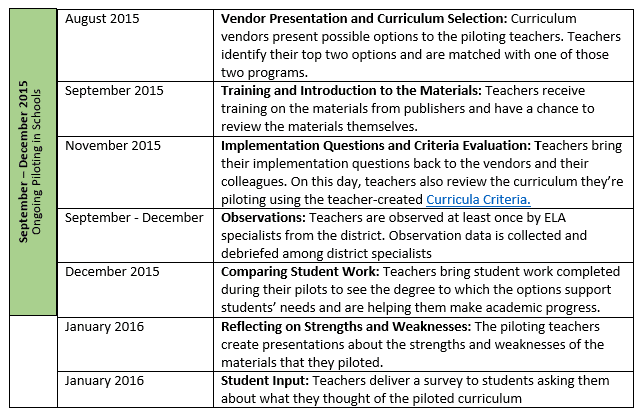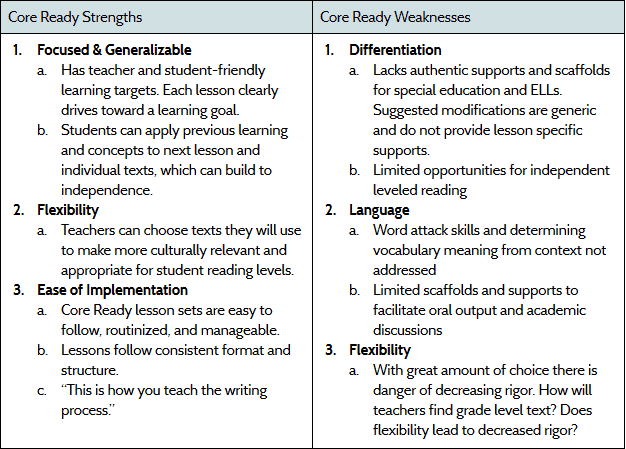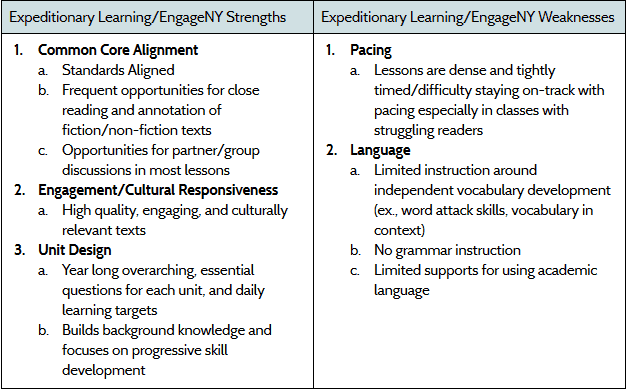While it would seem almost unthinkable to buy a car without test driving it, most districts today purchase curricular materials without having teachers try the curriculum with students. Oakland Unified School District (OUSD) chose to do things differently, however. Instead of taking the textbook sales representatives’ words at face value, they decided to let teachers, school leaders, and students themselves be the judge of whether or not different curriculum options really matched up to the promises and would be a good fit for its schools. District leaders had teachers identify the criteria that were used to evaluate the curriculum and then supported teachers and leaders as they engaged in a thorough evaluation of how each criterion measured up. See more on the criteria in a previous Aligned post.
The Piloting Process
Any interested 6th-8th grade teacher could volunteer to pilot a potential new middle school curriculum with their students. Once the piloting teachers were selected, they engaged in the following pilot process:
 From this process, OUSD was able to narrow down the potential curriculum options to the three most recommended options among piloting teachers.
From this process, OUSD was able to narrow down the potential curriculum options to the three most recommended options among piloting teachers.
There were clear trends in terms of the strengths and weaknesses of each program. After working with the materials for several months, the educators reported the strengths and weaknesses of the final three contenders and how well they felt the materials reflected the criteria in the teacher-written Curricula Criteria. Below is the feedback from the teachers piloting the materials.
Principals Review and Make a Decision
ELA specialists presented the pros and cons of each program to principals in the district. Principals also viewed videos, a PowerPoint about the different options, and unit maps. As they reviewed the content and teacher reports, principals discussed concerns about each of the programs as well as the strong points of the curricula. The principals liked the technology incorporated in Amplify and thought it would be engaging to students. They also liked the immediate access to data and “eyes up” features that directed attention back to the teacher. Concerns were raised about Amplify’s limited student talk time and the lack of diversity and relevancy of texts, however.
With Core Ready, principals were concerned that there were so many text options that cross-site work would be challenging. They also noticed issues of Standards-alignment, and a lack of student support features.
After reviewing the piloting teachers’ findings, the principals voted and unanimously chose Expeditionary Learning curriculum (often called EngageNY because of the company’s previous work with the New York curriculum). They liked the program’s cultural responsiveness, constructivist pedagogy, high rigor, and units that build on previous skills. They did raise concerns, however, about pacing, the level of scaffolding that would be needed to help all students access the materials, and the potential printing costs associated with producing the materials.
In addition to receiving the highest marks from piloting teaches, Expeditionary Learning/Engage NY also received positive feedback from students: the majority of students (63%) found the lesson they were surveyed about interesting and engaging, 81% found the difficulty level just right – neither too easy/boring, nor too challenging/frustrating, and 72% rated the lesson they were surveyed about as either a 3 or a 4 overall on a 4 point scale. These ratings were higher than for the other two programs.
How is OUSD implementing their new curriculum and what challenges still remain? Find out in the next post in the Oakland Case Study Series!





















